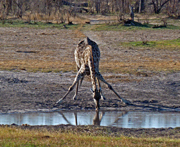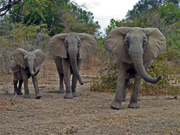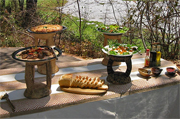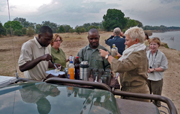 We’ve seen elephant before—quite a number of elephant. But this is a really lot of elephant. As the sun creeps lower toward the horizon, we’ve rolled up to a water hole that’s holding a literal convention of the grey giants. This is a number of herds converging at once. A rough count in a 180-degree sweep indicates there are at least 200 jumbos here. Many drink and squirt water over their backs and under their bellies at the waterhole’s edge. Several juveniles roll, kneel, and cavort in a mud pit, charcoal hides dark with muddy water. Groups of females cluster with their young winding under and around the adults. Two young males spar and mock charge, trumpeting, flapping ears and twining trunks and pulling. For us they are the most fascinating of all the creatures to watch. And since this is Zambia, where safari tourism is just flowering in recent years, there is no one else around. We’re alone in a sea of elephant.
We’ve seen elephant before—quite a number of elephant. But this is a really lot of elephant. As the sun creeps lower toward the horizon, we’ve rolled up to a water hole that’s holding a literal convention of the grey giants. This is a number of herds converging at once. A rough count in a 180-degree sweep indicates there are at least 200 jumbos here. Many drink and squirt water over their backs and under their bellies at the waterhole’s edge. Several juveniles roll, kneel, and cavort in a mud pit, charcoal hides dark with muddy water. Groups of females cluster with their young winding under and around the adults. Two young males spar and mock charge, trumpeting, flapping ears and twining trunks and pulling. For us they are the most fascinating of all the creatures to watch. And since this is Zambia, where safari tourism is just flowering in recent years, there is no one else around. We’re alone in a sea of elephant.
Africa has been our itinerary many times, going back almost thirty years. Not sure how many more safari’s are in our travel bag of tricks, we decided when planning this trip that it should be comfortable and high-quality, but hark back as closely as possible to our original experience with a private tented safari in a lesser-known area of the Masai Mara: that meant less-visited places, small camps, real tents, and emphasis on animals—rather than 5 star luxury lodge and spa experience in parks like Kruger. Zambia seemed a good bet, as it’s much newer to the world of safari tourism than Kenya, Tanzania and South Africa, and a more ‘old Africa’ type of adventure.
 We arrived in Zambia two nights ago, after literally days of travelling, and finally reached the South Luangwa National Park’s main gate by Cessna from Zambia’s capital, Lusaka. Another two hours winding through the dark, catching fleeting glimpses of our first animals brings us to our first bushcamp. Chindeni Camp appears in the dark as a string of amber glowing beads strung along the tree-lined bank of a sweeping ox-bow lagoon. The beads resolve into oil lamps and candles hung around the open-air thatched-roof dining and lounge area—the camp is completely solar—and this old-fashioned lighting saves energy and provides a lovely nighttime atmosphere too. The camp consists of the multi-level wood decked main gathering area, perched on stilts built in and around huge ebony and tamarind trees fifteen feet above the lagoon level. It has a sweeping view of the ox-bow lagoon, which we’ll see at sunrise the next morning. Our land rover rolls to a halt and James, the camp manager, greets us with hot towels in a basket. We soon meet the other six guests and join them for a late dinner. The next day we get a better look at that fantastic view, and at the layout of camp. There are four tents atop stilt platforms, spaced out two in each direction from the main area, the whole camp accommodating 8 guests. Each tent consists of a large sitting area, bathroom with open rain shower and mosquito-netted canopy bed. A covered porch with hammocks provides additional relaxing & lagoon-viewing area.
We arrived in Zambia two nights ago, after literally days of travelling, and finally reached the South Luangwa National Park’s main gate by Cessna from Zambia’s capital, Lusaka. Another two hours winding through the dark, catching fleeting glimpses of our first animals brings us to our first bushcamp. Chindeni Camp appears in the dark as a string of amber glowing beads strung along the tree-lined bank of a sweeping ox-bow lagoon. The beads resolve into oil lamps and candles hung around the open-air thatched-roof dining and lounge area—the camp is completely solar—and this old-fashioned lighting saves energy and provides a lovely nighttime atmosphere too. The camp consists of the multi-level wood decked main gathering area, perched on stilts built in and around huge ebony and tamarind trees fifteen feet above the lagoon level. It has a sweeping view of the ox-bow lagoon, which we’ll see at sunrise the next morning. Our land rover rolls to a halt and James, the camp manager, greets us with hot towels in a basket. We soon meet the other six guests and join them for a late dinner. The next day we get a better look at that fantastic view, and at the layout of camp. There are four tents atop stilt platforms, spaced out two in each direction from the main area, the whole camp accommodating 8 guests. Each tent consists of a large sitting area, bathroom with open rain shower and mosquito-netted canopy bed. A covered porch with hammocks provides additional relaxing & lagoon-viewing area.
The oxbow lagoon was originally a portion of the broad serpentine Luangwa River, which was separated when the river changed course during one flood season. The summer floods swell the river and the lagoon both, and the water level rises fifteen or more feet coming all the way up to the edge of the deck, which seems so high now in the dry season. Most of the bushcamps are closed in the wet season, and in fact two years ago, Chindeni was flooded to the point where only the tops of the tents were visible. Acacia and mopane forests surround the camp, and the cross-lagoon view is of a cropped green plain, fringed by woodlands with the Chindeni hills in the background across the river. Clouds dapple the hills with patches of mauve shadow and burnt gold sunlight. Several hippos inhabit the lagoon, and huge crocs sun themselves on the opposite bank. Over the course of a day the opposite plain holds herds of Impala and puku and a clutch of twisted-horned Kudu. A hundred or so Cape buffalo munch placidly, a couple dozen elephants in small groups meander down to the water, trailed by a trio of whip-tailed warthogs, and several pair of Thornicroft’s giraffes bend to drink, keeping a wary eye out for crocodile. Birdlife is plentiful, and we spot Egyptian geese, large red-billed ground hornbill, nun-habited sacred ibis, grey heron, helmeted guinea fowl and saddle-billed stork standing quietly fishing in the water’s edge, beak open and ready.
plentiful, and we spot Egyptian geese, large red-billed ground hornbill, nun-habited sacred ibis, grey heron, helmeted guinea fowl and saddle-billed stork standing quietly fishing in the water’s edge, beak open and ready.
 Zambia is one of a shrinking number of places where walking safaris are possible, and South Luangwa is known for them. So a typical day at Chindeni starts with a wake-up call (one of the staff lowly calling “knok-knok” outside the tent) at quarter to six, a quick cup of tea and piece of fire-grilled toast on the deck, and into the land rover to head out into the bush. A 30-45 minute drive brings the group to the starting point of a trek through the wild. Clearly we’ll be vulnerable to all of the predators that abound in the bush, so the point man is our scout, Godrick, who carries a .458 caliber rifle, with which he’s proven the ability to drop an elephant at good distance in order to earn his license. Next comes Peter, our guide, who informs us that rarely has there been a need to fire, and even then only as a warning. But walking into the bush unarmed would be folly. We are instructed to walk single file, quietly, behind Peter, and the rear is brought up by the junior guide, William.
Zambia is one of a shrinking number of places where walking safaris are possible, and South Luangwa is known for them. So a typical day at Chindeni starts with a wake-up call (one of the staff lowly calling “knok-knok” outside the tent) at quarter to six, a quick cup of tea and piece of fire-grilled toast on the deck, and into the land rover to head out into the bush. A 30-45 minute drive brings the group to the starting point of a trek through the wild. Clearly we’ll be vulnerable to all of the predators that abound in the bush, so the point man is our scout, Godrick, who carries a .458 caliber rifle, with which he’s proven the ability to drop an elephant at good distance in order to earn his license. Next comes Peter, our guide, who informs us that rarely has there been a need to fire, and even then only as a warning. But walking into the bush unarmed would be folly. We are instructed to walk single file, quietly, behind Peter, and the rear is brought up by the junior guide, William.
Over the course of some three hours, we spot elephant, hippos, wart hog, impala, kudu and lots of puku, a tan antelope found only in Zambia and the Congo. One can never get as close to game on a walking safari, as the animals view the vehicles neutrally, but man on foot as a predator. Still, it’s plenty close to a 2-ton hippo or 5-ton elephant that can easily—as they say out here—turn you into strawberry jam. Walking safaris are as much about seeing small things such as the elusive ant lion, and learning bush lore, like how to tell if an elephant is young or old from the composition of his dung. Or the difference between leopard and cheetah prints; whether a track in the sand is fresh this morning, or a day or more old; and which direction, and how fast that elephant was walking. After a couple hours William breaks out cups and a thermos of tea, and a tin of camp-made biscuits from his backpack, and we refresh ourselves a bit before the final hour back to the vehicle.
puku, a tan antelope found only in Zambia and the Congo. One can never get as close to game on a walking safari, as the animals view the vehicles neutrally, but man on foot as a predator. Still, it’s plenty close to a 2-ton hippo or 5-ton elephant that can easily—as they say out here—turn you into strawberry jam. Walking safaris are as much about seeing small things such as the elusive ant lion, and learning bush lore, like how to tell if an elephant is young or old from the composition of his dung. Or the difference between leopard and cheetah prints; whether a track in the sand is fresh this morning, or a day or more old; and which direction, and how fast that elephant was walking. After a couple hours William breaks out cups and a thermos of tea, and a tin of camp-made biscuits from his backpack, and we refresh ourselves a bit before the final hour back to the vehicle.
The morning outing returns to camp a bit before eleven, and lunch is served around 11:30. Chef prepares things like frittata, cold grilled chicken, tomato and cucumber tossed with feta, and cold pasta salad; all quite delicious and healthy, and liberally sprinkled with ‘hungry sauce’ from our morning’s trek. Midday is given over to reading, writing, photo editing and siesta. Tea at 3:30, and back out into the bush for the afternoon/evening game drive. After a couple hours meandering and looking at game, the rover stops at the edge of a cliff overlooking the broad Luangwa River as the sun dips below the
prepares things like frittata, cold grilled chicken, tomato and cucumber tossed with feta, and cold pasta salad; all quite delicious and healthy, and liberally sprinkled with ‘hungry sauce’ from our morning’s trek. Midday is given over to reading, writing, photo editing and siesta. Tea at 3:30, and back out into the bush for the afternoon/evening game drive. After a couple hours meandering and looking at game, the rover stops at the edge of a cliff overlooking the broad Luangwa River as the sun dips below the  horizon. The front grill drops down into a bar, and beer, white wine and gin and tonics are distributed for ‘sundowner’, a safari tradition. A fish eagle soars over the far bank, elephant drink and bathe in the rivers edge, hippos blow, snort and erupt from the river, and crocs soak up the last rays of the sun before slipping silently into the darkening steel-blue water. The evening portion of the drive is when the shy and elusive nocturnal animals can be spotted, starting with the leopard, and working down through lesser but possibly rare lights, such as honey badger, elephant shrew, and civet and genet cats, whose eyes reflect the spotlight as glowing points. Back at camp by eight, there is just time for a bush martini—gin on the rocks, before dinner.
horizon. The front grill drops down into a bar, and beer, white wine and gin and tonics are distributed for ‘sundowner’, a safari tradition. A fish eagle soars over the far bank, elephant drink and bathe in the rivers edge, hippos blow, snort and erupt from the river, and crocs soak up the last rays of the sun before slipping silently into the darkening steel-blue water. The evening portion of the drive is when the shy and elusive nocturnal animals can be spotted, starting with the leopard, and working down through lesser but possibly rare lights, such as honey badger, elephant shrew, and civet and genet cats, whose eyes reflect the spotlight as glowing points. Back at camp by eight, there is just time for a bush martini—gin on the rocks, before dinner.
Camp meals can be less than adventurous if management isn’t creative. Fortunately, most are, and James and the chef have conjured a treat. The dinner table is set down on the beach area below the main decks, with flaming torches holding back the dark. Two huge iron woks sit over a crackling log fire, behind which the chef and his assistant wait. An array of sliced vegetables, noodles, slivered beef and pork, condiments and spices cover a buffet table. Each diner fills a plate with his or her selection, and then hands it to the chef, who stir-fries it furiously for a couple of minutes before transferring it steaming back to the dinner plate. Pad Thai in the bush is both hugely entertaining and delicious. After a while Sam, the major domo, slinks off and reappears shortly leading the staff in a line back into the clearing clapping, skipping along and singing African folk songs in beautiful a capella harmony. There is something captivating and hypnotic about African rhythms and melodies—Paul Simon made great use of them—and they create a mood that is mesmerizing.
A full moon rises blood-red over the Chindeni Hills, and the forest outside the tent screen is dappled light and shadow. The warning bark of baboons indicates they have probably spotted a leopard hunting in the night. Night sounds are a layered drone of cicadas, birdcall, coo of cape dove, loud snort of hippo and the marimba-like call of the bell frogs. As we’re lulled to sleep by the forest sounds we realize that we’ve found our Africa of old—vast spaces, stunningly beautiful vistas, plentiful game we can get close to, and just us—and a very few other savy travelers. 